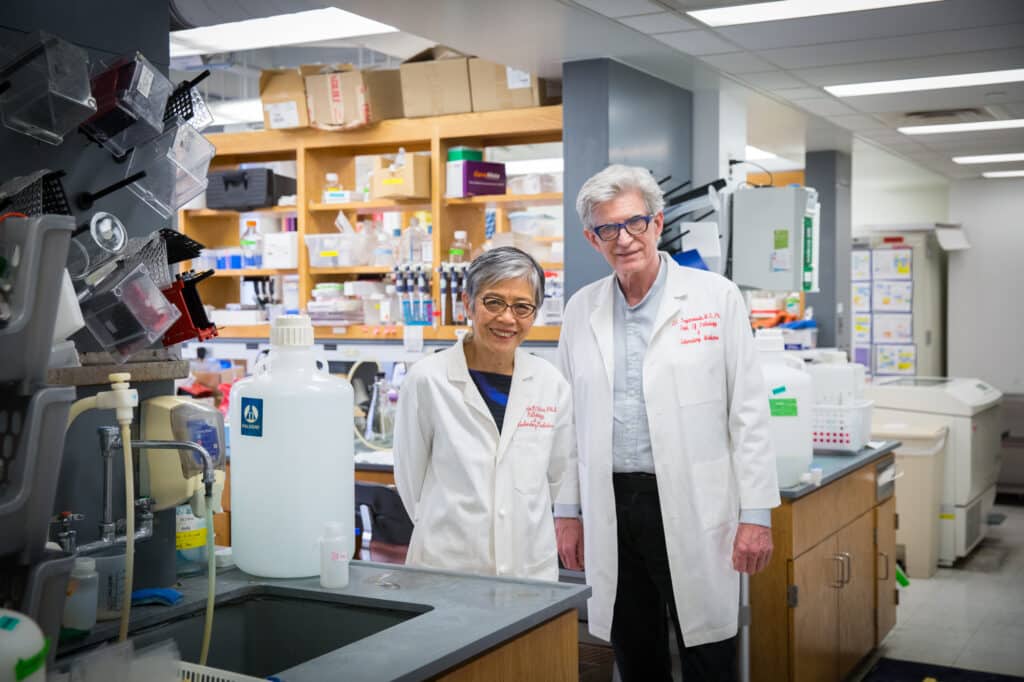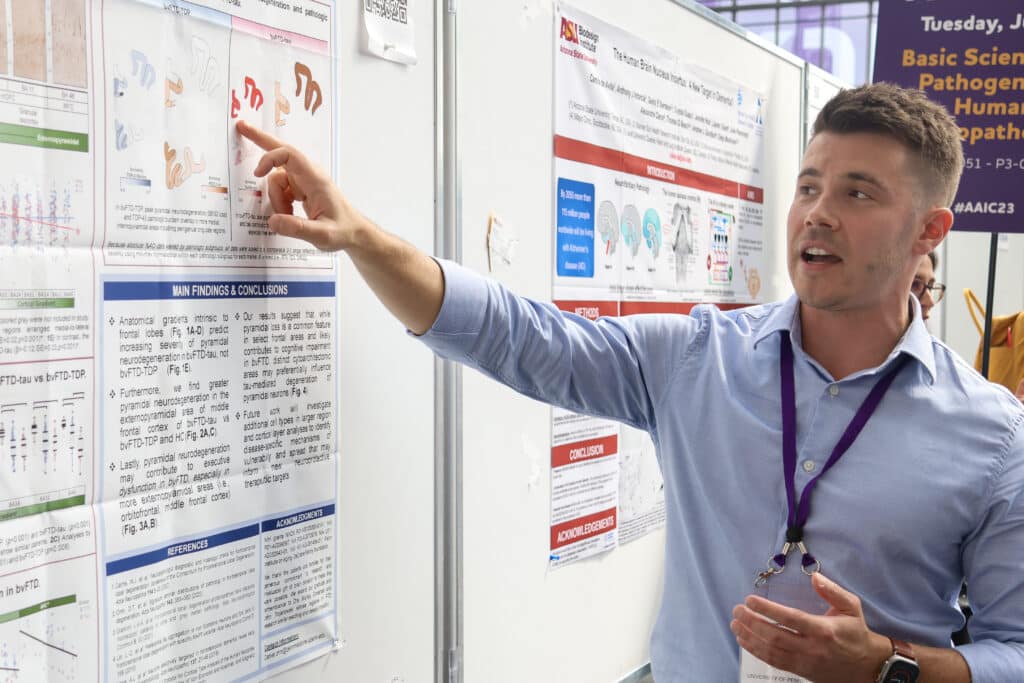
Drs. Virginia Man-Yee Lee and John Trojanowski
By Meg McCarthy
Discovered years ago by a team of Penn researchers, TDP-43 (transactive response DNA binding protein of 43 kDa) is the focus of several presentations at this year’s Alzheimer’s Association International Conference (AAIC).
The identification of TDP-43 was years in the making. Now, Virginia Man-Yee Lee, PhD, Director of the Center for Neurodegenerative Disease Research (CNDR), has dedicated her career to training the next generation of researchers devoted to this work.
From its discovery and impact to current research applications, here’s what to know about TDP-43.
Origin story
Alzheimer’s disease and related dementias (ADRDs) have both clinical and pathological associations.
Clinically, ADRDs can cause symptoms such as memory loss, personality change, and confusion. They also have an impact on brain pathology, or changes in the brain due to disease. Pathologically, patients with ADRDs usually exhibit abnormal protein deposits, often in the form of amyloid-beta plaques, and/or tau tangles.
In 2006, John Trojanowski, MD, PhD, Virginia Man-Yee Lee, PhD, and Mark Forman, MD, PhD found a novel protein associated with ADRDs and other neurodegenerative diseases such as atherosclerosis (ALS). The team deemed the protein TDP-43.
“The science I am most proud of is the discovery of TDP-43,” said Dr. Lee.
Together, they spent more than four years trying to understand the protein and found that more than half of patients with frontotemporal dementia had abnormal aggregates of TDP-43 (FTLD-TDP). They were also able to link TDP-43 deposits to patients with ALS and AD.
“We scratched our head and said, well, what is this?’” said Dr. Lee. “Over years, we were able to link it all together. It’s been incredible, over time, to see how researchers across the world have used it to develop new models and studies.”

Drs. Lee and Sílvia Porta with fellow researchers at AAIC 2023
A pivotal discovery in ADRDs
Now, the specific role TDP-43 plays in disease progression is a key focus of ADRD research.
At this year’s AAIC, Sílvia Porta, PhD, Research Assistant Professor of Pathology and Laboratory Medicine at the Perelman School of Medicine, is presenting on current findings about the protein.
Dr. Porta’s team specifically focuses on TDP-43 proteinopathies. This term is used to describe neurodegenerative disorders associated to accumulation misfolded TDP-43 protein within brain cells.
“We study the mechanism of TDP-43 misfolding and aggregation,” said Dr. Porta. “We want to understand the mechanism/s and the consequences of TDP-43 aggregation to find and screen potential therapeutic targets in the future.”
Dr. Porta describes TDP-43 as a key regulator within the brain. It has many functions and regulates many pathways and key processes. “If TDP-43 is not properly folded, it aggregates” said Dr. Porta. “As a key regulator, if it fails, a lot of things fail underneath.”
TDP-43 is a nuclear protein, meaning its primary function is in the nucleus of a cell. In patients with ADRDs, often aggregates of TDP-43 are found outside of the nucleus. This can have a harmful impact on the function of brain cells.
Specifically, Dr. Porta uses animal and cell models to simulate what happens in the brains of patients with FTLD-TDP, ALS or AD. To do this, her team injects lysates containing pathogenic TDP-43 proteins isolated from human brain autopsies.
Distinctive distribution and the morphological features of TDP-43 aggregates in the brain are associated to different clinical symptoms within and between diseases like FTLD-TDP and ALS. However, further research is needed to understand how this works.

Dr. Daniel Ohm
A next generation of researchers
At AAIC 2023, many research presentations focused on the role of TDP-43 in ADRDs.
Daniel Ohm, PhD, Research Associate at the Penn Frontotemporal Degeneration (FTD) Center, for example, is presenting research on newly characterized patterns of neurodegeneration (neuron loss) in FTD patients with either tau or TDP-43 pathology. His work is specifically interested in understanding if tau pathology and TDP-43 pathology cause different types of neurons to die in the brain.
In patients with the behavioral variant of FTD, for example, his team found that larger pyramidal neurons known for longer, excitatory projections in the brain, may die more in patients with tau pathology compared to those with TDP-43 pathology.
“While this work should be replicated in independent cohorts, these data tells us that one type of neuron may be more vulnerable than another, depending on the disease,” said Dr. Ohm. “Down the road, this could help us with potential treatment targets to slow disease progression.”
Ultimately, this work is reliant upon generosity from patients.
“We are able to do this work through individuals donating their brains for research,” said Dr. Porta. “This is a collaboration of families and researchers. Without them, we wouldn’t be able to do this work.”
To learn more about brain donation please click here.